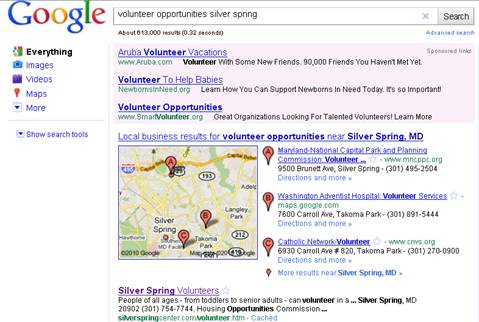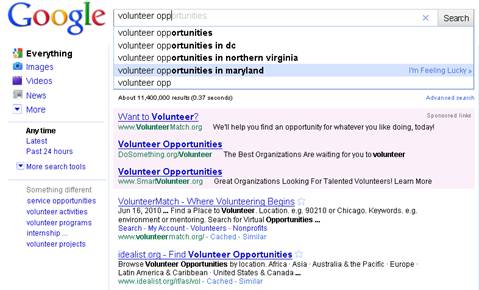Guest post by Erica Holt
By now
you’ve most likely heard of Google Instant, a search enhancement that shows search results as you type.
Image: Greig Christie via Flickr, Creative Commons
Since Google Instant’s launch just over a month ago, digital marketers have been scrambling to figure out how search engine marketing strategies might need to change.
While it’s too soon to tell
what effects Google Instant might have on your search traffic or how best to adapt marketing efforts, some have speculated that small businesses may be more affected than large organizations.
Others have speculated than shorter searches will dominate longer, more specific (long tail) searches.
This would mean the same number of organizations competing for a smaller number of keywords.
(So far, early research indicates little difference in the length of searches since Google Instant.)
What does Google Instant mean for non-profit organizations?
When applied to non-profits, these initial theories on Google Instant’s implications for search engine marketing may affect small non-profits more than larger non-profits.
For example:
Let’s say you are searching for volunteer opportunities in Silver Spring, Md.
With Google Instant turned off, you come up with results for small local organizations including Washington Adventist Hospital Volunteer Services and Silver Spring Volunteers.
Try the same search for volunteer opportunities, but this time using Google Instant.
Results show as you type and before you finish typing the word opportunities, several potentially relevant results show up for VolunteerMatch and idealist.org.
While I have great respect for these two organizations, they are not local to my search.
Chances are good the searcher may select VolunteerMatch or idealist.org prior to finishing the complete search.
In this case, the local organizations are pushed out by the larger national volunteer organizations and they may miss out on some search traffic.
Of course, I am making some assumptions here.
If web metrics from these local sites start showing less referral traffic from Google, then it’s surely possible that Google Instant is, at least in part, to blame.
Seven Tips for Adapting to Google Instant
Regardless of whether you are a small non-profit or a larger organization, there are a few steps you can take to prepare for possible affects over time resulting from Google Instant:
Don’t forget about Bing and Yahoo!
Bing, Nielsen recently reported, received nearly 14 percent of search traffic in August 2010. Yahoo! received 13 percent.
Bing offers an excellent guide on how to optimize sites (PDF) for its search engine.
Relevant content is, and will continue to be, key to reaching searchers.
If you focus on one thing, focus on this: creating timely, engaging content that meets the needs of your target audiences.
Pre- and post-Google Instant, this is key.
You might not notice any changes right away.
All Google searchers are not necessarily using Google Instant.
Many people use toolbar search boxes for which Google Instant is not currently available.
Search algorithms.
Technically, the launch of Google Instant did not bring a change in Google’s search algorithm.
If anything, Google Instant means you should enhance what you may already be doing to optimize your site for target keywords relevant to your audiences.
Importance of search engine rankings.
As much as ever before, ranking on the first page of Google’s search results will continue to be important. Users are more likely to click on results on the first page.
If competition grows for more general keywords, such as the volunteer opportunity search discussed above, there will actually be more opportunity to optimize for more specific long-tail search terms.
Keyword research.
Finding those keywords your users are searching for most frequently is getting easier.
The predictive text and results that show in Google Instant for various keyword combinations are in themselves excellent tools to find the most relevant keywords to use for your site.
Pay-per-click (PPC) advertising costs might increase.
If you use Google’s PPC ads for fundraising or other purposes, you may find more general keywords increasing in cost.
Ads will also continue changing as users type, which could decrease click-through rates.
Have any of you noticed traffic changes to your site since Google Instant’s launch? What are your thoughts on how Google Instant might affect non-profit organizations? I look forward to hearing from you in the comments.
 Erica Holt has more than 8 years experience developing digital marketing strategies for non-profit and public sector clients. She lives in Takoma Park, Md, with her husband and two young sons. You can catch up with her on Twitter or by e-mail.
Erica Holt has more than 8 years experience developing digital marketing strategies for non-profit and public sector clients. She lives in Takoma Park, Md, with her husband and two young sons. You can catch up with her on Twitter or by e-mail.



![[EVENT]: PR Hacks for Small Biz (online)](https://shonaliburke.com/wp-content/uploads/2021/06/FB-Ad-1200x800-01-01-01-Copy-500x383.jpeg)








Erica,
One more point about user behavior: SEO isn’t always a zero-sum, one-search one-result game. With Instant on, users will be exposed to a greater number and wider diversity of sites. Those of use who multi-tab and are easily distracted may end up looking at a lot more sites, at least for a moment.
To capitalize on this effect, each web page should have an attractive meta-description tag, and landing pages should be “sticky” with both content and user-interface.
Great stuff Erica! I have to admit I didn’t really give much thought to how this would affect search optimization but you laid it out really clear and easy to understand here. It’s one of those things that despite whatever changes are going on with the Web, making sure good content is out there is key. Staying relevant in your field is what people draw you to them.
Andre, You are totally right about staying relevant. That’s what Nedra pointed out as well, and I agree that nothing is more important that content relevant to your audience. At the same time, there’s always little things we can do with SEO and keyword optimization to help get the word out to a broader audience.
Like you said, Erica, excellent relevant content is the best way to get found on any search engine. I suspect that people are learning to be more specific in their search phrases, especially for local searches. Using Google Instant just reminds me of how much information overload is out there!
Nedra, Yes, and Dan said this in his comment as well, people are likely changing the way they search and will probably adapt to Google Instant over time. How much fun we have trying to keep up! Thanks for commenting :) :)
Nice write-up Erica! I agree that the fundamentals of SEO won’t change too much, though smaller organizations will probably have to put more resources into them, as groups with a larger web presence may see their lead increase.
I’m really looking forward to potential changes in search behavior, though. Currently, most people think out a search phrase, then enter it. But using Instant raises the possibility of more “foraging” type of behavior. Users may start with one word, and keep adding words as they see the results evolve. Instead of an initial phrase, users may eventual use phrases that keep adding more specific terms until they find what they want.
Thanks for your comment, Dan. I agree that the changes over time in search behavior will be really interesting to watch. What you are describing is going to make keyword research a lot more difficult for us, but I agree that it’s surely a possibility that our search behaviors will change!
[…] Here’s my first post: How Google Instant Might Impact Your Small Nonprofit. […]
[…] This post was mentioned on Twitter by Shonali Burke, Erica Holt. Erica Holt said: RT @shonali: New! How Google Instant Might Impact Your Small #Nonprofit http://t.co/yWmBHsR by @ericaholt (guest post) […]